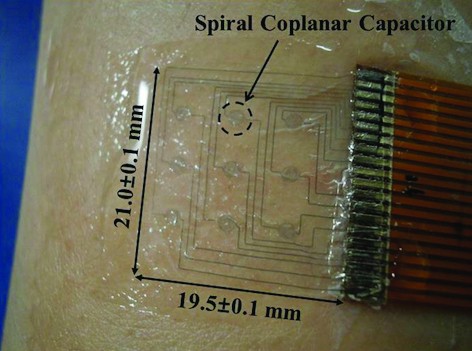The flexible, wearable 20mm x 20mm polymer sensor was developed by a team at the Korea Advanced Institute of Science and Technology (KAIST) in Daejeon to directly measure the degree and occurrence on the skin of goose bumps (a reaction also called piloerection), which is caused by sudden changes in body temperature or emotional states.
In use, the sensor could be used to quantitatively gauge a consumer’s real-time physical and emotional response to stimuli including music, adverts or room temperature.

Described in Applied Physics Letters, the technology is said to be based on a coplanar capacitor and detects goose bumps by virtue of a linear relationship between the deformation of the sensor and the decrease of the capacitance.
‘We found that the height of the goose bump and the piloerection duration can be deduced by analysing obtained capacitance change trace,’ team member Young-Ho Cho said in a statement.
While more work still needs to be done to correlate such physical measurements with emotional states, the work suggests that quantitatively monitoring goose bumps in real-time as an indicator of human physical or emotional status is possible, which could pave the way for personalised advertising, music streams or other services informed by directly access to the emotions of the end user.
‘In the future, human emotions will be regarded like any typical biometric information, including body temperature or blood pressure,’ Cho said.
Through use of microfabrication technology, Cho and colleagues built the sensor using a conductive polymer called PEDOT:PSS for the capacitors, which is flexibile compared to brittle metallic conductive materials.
The capacitors were embedded in a silicon substrate via a multi-step spin-coating process, giving them a spiral shape and coplanar structure. This gave them high capacitive density and high deformability while remaining 1.2 micrometres thick.
The silicon substrate - Ecoflex 0030 - was selected due to its biocompatibility and high degree of flexibility relative to human skin. It is also highly thermal and photo-stability, which allows the embedded polymer devices to maintain their performance in diverse conditions.
They attached these sensors to the inside of a 28-year old subject’s dorsal forearm and had him grab hold of ice cubes to induce a sudden cold shock. This stimulated piloerection, deforming the sensors and causing their capacitance to notably decrease.
Future work includes scaling down the signal processing module and capacitance measurement system to be co-mounted on skin with the sensor.




April 1886: the Brunkebergs tunnel
First ever example of a ground source heat pump?